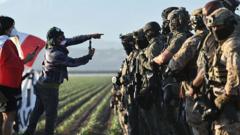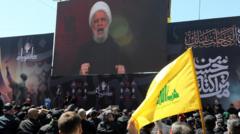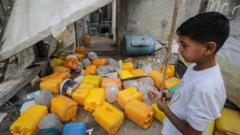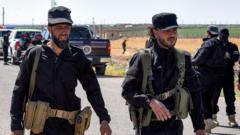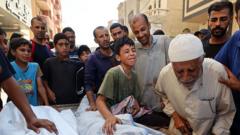As Gaza's new aid system unfolds, nearly 500 casualties are reported, adding to the scrutiny of Israel's military operations and humanitarian efforts amidst ongoing tensions.**
Chaos and Gunfire Mark First Month of Gaza's New Aid Distribution System**

Chaos and Gunfire Mark First Month of Gaza's New Aid Distribution System**
Following the introduction of a new aid distribution plan in Gaza, reports highlight a significant increase in violence and fatalities among those seeking assistance.**
A month after the rollout of a contentious aid distribution system in Gaza backed by the US and Israel, a BBC Verify investigation reveals a distressing pattern of gunfire and chaos that has left many seeking assistance in peril. Analysis of various videos shows recurrent incidents of shooting and disturbing scenes of panic as disbursements of aid continue to be met with violence.
The Hamas-operated Gaza health ministry reports that over 500 individuals have been killed and an estimated 4,000 injured while attempting to collect aid, largely attributing these incidents to Israeli gunfire, as stated by local officials and eyewitness accounts. Although BBC Verify lacks the means to conclusively attribute responsibility for these attacks, the overall atmosphere is one of confusion and continual risk for those attempting to access basic supplies.
In recent statements, the Israel Defense Forces (IDF) claimed to fire "warning shots" at individuals they deemed threats. The IDF has asserted that Hamas actively hampers the effectiveness of aid delivery efforts and endangers local populations. The aid operation commenced on May 26, following a partial easing of the blockade Israel had enforced since February, aiming to exert pressure on Hamas for hostages' release.
Four distribution sites built by the IDF, selected within heavily secured areas, aim to adapt aid delivery methods, but the UN argues that these protocols jeopardize the safety of the people who must traverse perilous territory to reach this aid. Since the program's inauguration, reports of fatalities among aid seekers have emerged, leading to condemnation from the international community.
Despite Israeli government denials regarding casualty figures, the situation on the ground remains bleak, with institutions like the Red Cross reportedly activating mass casualty procedures frequently due to the consistent injuries among aid seekers. Human rights advocates have warned that attacks on civilians under the pretense of maintaining security may equate to serious breaches of international law, possibly amounting to war crimes.
Footage from the region depicts gruesome scenes of individuals fleeing amidst automatic gunfire, emphasizing the dire state of security for those involved in receiving humanitarian aid. Meanwhile, the Gaza Humanitarian Foundation (GHF) contends claims of fatalities near their distribution points and remains committed to its aid distribution, which has reportedly provided meals to two million residents.
As chaos reigns around the aid delivery efforts, calls for increased humanitarian support persist, highlighting the urgent need for stability amidst ongoing tensions within the region. While the GHF and other aid organizations continue their work, concerns remain regarding the ongoing safety of Palestinians seeking essential resources. The situation warrants continued international scrutiny and dialogue as humanitarian and security needs converge in this volatile landscape.

